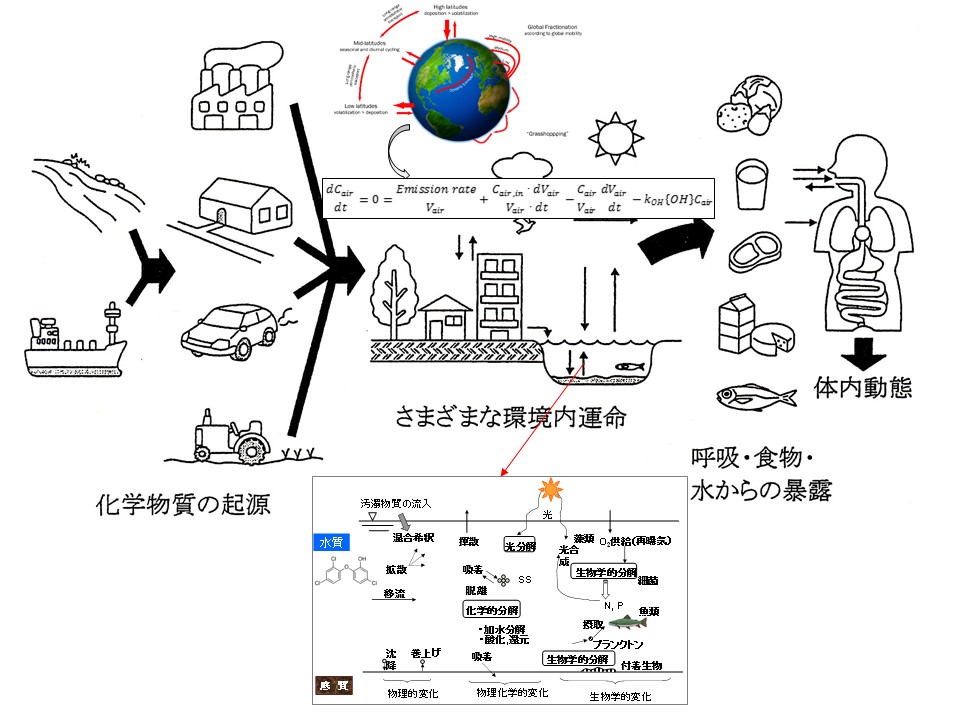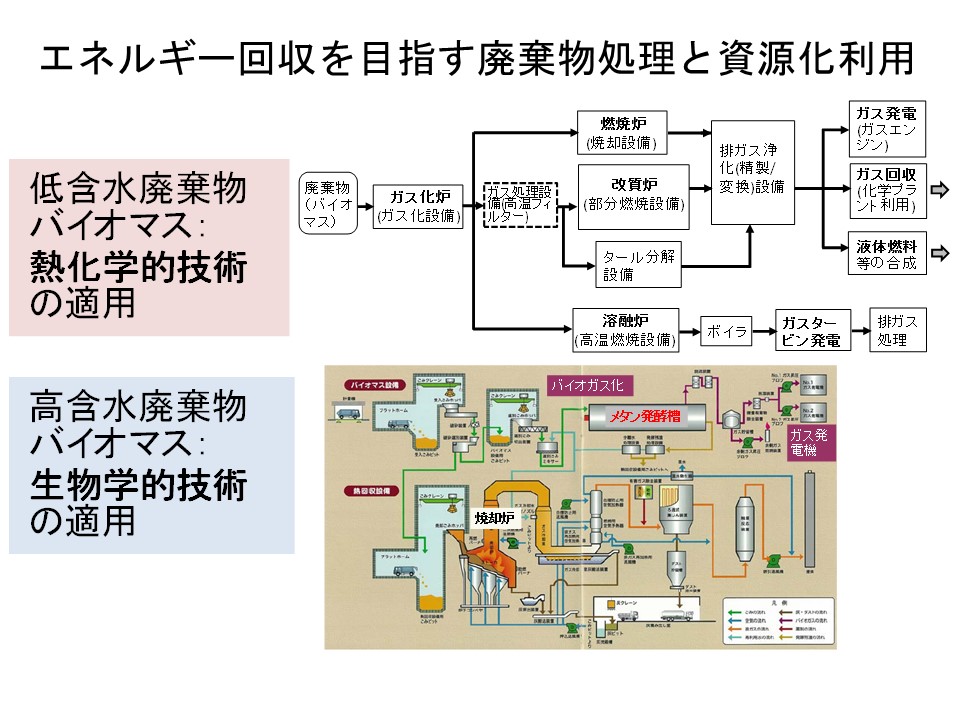Environmental Measurement and Control
Staff
Research Topics
To sustainably develop and circulate materials, we are conducting education and research with regard to environmental controls and protection and further technology development. The methodologies used are 1) measuring synthetic chemicals in water and air samples and their fate, and 2) evaluating the fate of these chemicals on artificial/engineered processes, including waste water and flue gas treatment and solid waste disposal. Empirical researches based on the meteorological observation are conducted focusing on the exchange process of greenhouse gas (GHG) related substances across atmosphere - agricultural vegetation or atmosphere - ocean interface. Furthermore, various processes are modeled based on the measured data, and up-scaling of the models are worked by use of satellite data.
Assessing the fate of chemicals in the environment and engineered processes
|
Concentration changes and dynamics of environmental chemicals are predicted and evaluated based on partition equilibrium properties of chemical compounds and their conversion/degradation kinetics. The target compounds are organohalogen compounds, PAHs, and other emerging pollutants. The target engineering processes include water treatment and gas cleaning, and solid/liquid waste treatment in such environmental media as water, air, soil, and sediment. |

|
Safe and appropriate disposal treatment of waste water, flue gas, and solid/liquid waste, and developing further technology for recovering materials/energy from waste
|
Various exhausts, such as wastewater, flue gas, and other anthropogenic waste emissions should be appropriately and safely disposed. Currently, material and energy recovery is highly desired in the context of establishing a sound material recycling society. Because energy recovery from waste treatment plays a key role in eliminating fossil fuel use and GHG emissions, research and development corresponding to the type and properties of waste are performed. Safety assessments of the systems are also conducted. |

|
Biochemistry of iron-oxidizing bacteria, and their application to bioremediation and bacteria leaching
|
Iron-oxidizing bacterium, Acidithiobacillus ferrooxidans, is one of the most important bacteria for bioremediation and bacteria leaching. However, this bacterium is limited by very late growth. In the present study, an electrochemical cultivation system characterized by high efficiency was developed. This study shows feasible and economical immobilization materials for heavy metal recovery and treatment systems. In addition, an enzyme of highly resistant A. ferrooxidans used for bioleaching was characterized. |
Evaluation of open-burning impacts of harvest residue on the GHG budget on crop fields.
|
"Open-burning" of harvest residue is often carried out in double-cropping agricultural fields. Effects of such residual incineration on exchange processes and characteristics of carbon dioxide, methane, nitrous oxide between atmosphere and cropland are quantitatively evaluated. |
Modeling and regional estimation of surface evapotranspiration
|
It is extremely important to know how much rainfall is returned to the atmosphere by evaporation and plant transpiration for understanding the impact on soil and ground environment, river flow rate, groundwater recharge, and underground mass transport. We aim to estimate regional evaporation in various land coverings by constructing some models that can estimate the amount of evaporation using general weather and satellite data. |
Investigation of variation in environmental factors around coastal and inland waters by use of satellite data.
|
In recent years, technological improvements of sensors mounted on artificial satellites are remarkable. With such remote sensing technology, various kinds of information on the global environment can be obtained with fine resolution at short intervals. Using these data, we aim to understand the changes in lakes and coastal environments in a wide area. |
Publication List
- 福永翔太, 田内裕人, 江種伸之, 平田健正, 川本克也:多種類の揮発性有機化合物に汚染された帯水層における原位置バイオレメディエーションの浄化効果, 土木学会論文集B1(水工学), Vol.73 (4), I_61-I_66 (2017)
- B. Lu, Y. Ju, T. Abe, K. Kawamoto : Direct scanning electron microscopy observation of the dispersion of transition metal ion on mesoporous silica support, Journal of Nanoscience and Nanotechnology, Vol.17, 6890-6893 (2017)
- B. Lu, Y. Ju, T. Abe, K. Kawamoto : Hydrogen-enriched producer gas production and chemical conversion to usable gas product through biomass gasification using NiO nanoparticles dispersed on SBA-15, Journal of Nanoscience and Nanotechnology, Vol.17, 6190-6197 (2017)
- K. Kawamoto, B. Lu : Gasification and reforming of biomass and waste samples by means of a novel catalyst, J Mater Cycles Waste Manag, Vol.18, No.4, 646-654 (2016)
- K. Kawamoto, H. Miyata : Dioxin formation and control in a gasification - melting plant, Environmental Science and Pollution Research, Vol.22, 14621-14628 (2015)
- 水原詩治, 川本克也, 前背戸智晴, 倉持秀敏, 大迫政浩:廃棄物焼却炉内における放射性セシウムの蓄積挙動, 環境放射能除染学会誌, Vol.3, No.3, 139-144 (2015)
- B. Lu, Y. Ju, T. Abe, K. Kawamoto : Dispersion and distribution of bimetallic oxides in SBA-15, its enhanced activity for reverse water gas shift reaction, Inorganic Chemistry Frontiers, Vol.2, 741-748 (2015)
- 釜田陽介, 阿部清一, 川本克也, 由井和子, 倉持秀敏, 大迫政浩:溶融技術による土壌等からのセシウム熱分離に関するプラント実証試験評価, 環境放射能除染学会誌, Vol.3, No.2, 49-64 (2015)
- B. Lu, Y. Ju, T. Abe, K. Kawamoto : Grafting Ni particles onto SBA-15, and their enhanced performance for CO2 methanation, RSC Advances, Vol.5, 56444-56454, (2015)
- B. Lu, K. Kawamoto : Thermo-chemical hydrogen production technology from biomass, Current Organic Chemistry, Vol.19, 447-454 (2015)
- Contribution of pharmaceuticals and personal care products (PPCPs) to whole toxicity of the water samples collected in effluent-dominated urban streams; Ikumi Tamura, Yusuke Yasuda, Kei-ichiro Kagota, Saori Yoneda, Norihide Nakada, Vimal Kumar, Yutaka Kameda, Kumiko Kimura, Norihisa Tatarazako and Hiroshi Yamamoto, Ecotoxicology and Environmental Safety, (2017) in press
- Chronic toxicity of an environmentally relevant mixture of pharmaceuticals to three aquatic organisms (alga, daphnid, and fish); Haruna Watanabe, Ikumi Tamura, Ryoko Abe, Hitomi Takanobu, Ataru Nakamura, Toshinari Suzuki, Akihiko Hirose, Tetsuji Nishimura and Norihisa Tatarazako, Environmental Toxicology and Chemistry, 35(4), 996-1006 (2016)
- 生物応答を用いた排水試験法案の検証と事業場排水の実態調査; 渡部春奈、林 岳彦、田村生弥、中村中、阿部良子、高信ひとみ、荻野仁子、小塩正朗、鑪迫典久, 環境化学, 25(1), 43-54 (2015)
- 徳島県内の事業所排水を対象にしたTIEの事例; 山本 裕史, 池幡 佳織, 安田 侑右, 田村 生弥, 鑪迫 典久, 環境化学, 25(1), 11-17 (2015)
- Fish multigeneration test with preliminary short-term reproduction assay for estrone using Japanese medaka (Oryzias latipes); Ataru Nakamura, Ikumi Tamura, Hitomi Takanobu, Masumi Yamamuro, Taisen Iguchi and Norihisa Tatarazako, Journal of Applied Toxicology, 35(1), 11-23 (2014)
- Verification of responses of Japanese medaka (Oryzias latipes) to anti-androgens, vinclozolin and flutamide, in short-term assays; Ataru Nakamura, Hitomi Takanobu, Ikumi Tamura, Masumi Yamamuro, Taisen Iguchi and Norihisa Tatarazako, Journal of Applied Toxicology, 34(5), 545-553 (2014)
- Removal of Selected Pollutants in Household Effluent by Solidified Coal Ash and Water Lettuce; Hiroshi Yamamoto, Kei-ichiro Kagota, Akihito Hiejima, Ikumi Tamura, Hirofumi Kassai, Toshio Yamada and Motohiro Tanaka, Journal of Water Environment and Technology, 12(4), 389-406 (2014)
- Occurrence of preservatives and antimicrobials in Japanese rivers; Kumiko Kimura, Yutaka Kameda, Hiroshi Yamamoto, Norihide Nakada, Ikumi Tamura, Motonobu Miyazaki and Shigeki Masunaga, Chemosphere, 107 (7), 393-399 (2014)
- Ecotoxicity and screening level ecotoxicological risk assessment of five antimicrobial agents: triclosan, triclocarban, resorcinol, phenoxyethanol and p-thymol; Ikumi Tamura, Kei-ichiro Kagota, Yusuke Yasuda, Saori Yoneda, Junpei Morita, Norihide Nakada, Yutaka Kameda, Kumiko Kimura, Norihisa Tatarazako and Hiroshi Yamamoto, Journal of Applied Toxicology, 33(11), 1222-1229 (2013)
- Ecological risk assessment of urban creek sediments contaminated by untreated domestic wastewater: potential contribution of antimicrobials and a musk fragrance; Ikumi Tamura, Kumiko Kimura, Yutaka Kameda, Norihide Nakada and Hiroshi Yamamoto, Environmental Technology, 34(12), 1567-1575 (2013)